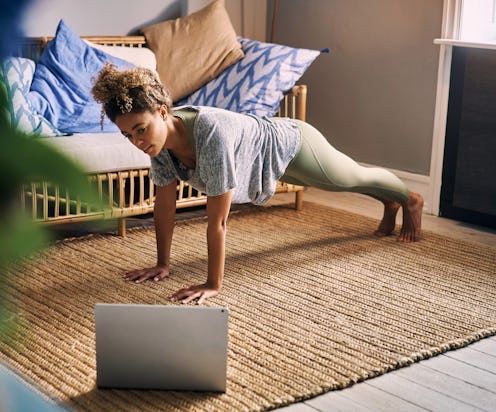Fitness
Fitness Pros Compare The Benefits Of The Plank Vs. Reverse Plank
Either way, you'll feel the burn.

Whether your workout involves the reverse or standard plank variation, you’re guaranteed to feel the burn in your ab muscles. But, even though both exercise moves are associated with core work, each type of plank does come with its own unique set of benefits.
The standard variation is, of course, the high plank. According to Pilates teacher Gia Calhoun, the proper way to do it is by coming onto all fours, stacking your hands or elbows under your shoulders, stepping your feet back behind you, and then lifting your body off the floor. You’ll then hold this position as you maintain a straight spine.
To do a reverse plank, think of that same move but flip it upside down, says SLT workout founder Amanda Freeman. “With your front body facing towards the ceiling, rest your hands or forearms on the ground below you, and extend legs straight out so your heels are on the floor,” she tells Bustle. Your hips will be lifted as you hold and feel the burn.
Regardless of the plank variation you’re doing, it’s important to focus on form so you get the most benefit out of the move. Depending on which plank you do, you’ll notice different parts of your body lighting up. Which one you choose might come down to the muscles you’d like to work on a given day. Here, fitness trainers compare the benefits of a plank vs. reverse plank so you can figure out the one that’ll best suit your goals.
The Benefits Of Planks
According to Freeman, a standard plank primarily targets the core muscles since you keep them engaged in order to hold yourself up off the floor and maintain a straight back. As you’re holding that position and preventing your butt from lifting or navel from dropping towards the ground, you’ll really feel those deep abs working.
While a plank is considered a full-body exercise, certified personal trainer Heather Carroll, CPT says it benefits the front muscles of your lower body in particular. The act of keeping your legs extended works the quads, and balancing on your hands (or forearms if you’re doing a modification) hits the upper trapezius muscles, chest, lats, and shoulders. In proper form, Carroll says you’ll build up strength and endurance in all those muscles at once — all without moving.
You might also notice a reduction in back pain if you do planks on the regular, says Sweat Remix founder Angela Gentile. As your core and posterior chain get stronger, it’ll become easier to maintain a nice, upright posture throughout the day, and that can translate to fewer backaches.
Another perk of the exercise? Planks just so happen to serve as a great baseline for more advanced exercises, says Gentile. As you continue to work out, you’ll notice that planks get easier and easier, making them an ideal way to measure your fitness progress.
The Benefits Of Reverse Planks
Get into a reverse plank and you’ll activate your core, triceps, and biceps, as well as a whole host of muscle groups down the backside of your body. According to Gentile, the move targets the hips, glutes, back, and hamstrings because you have to hold yourself level and keep your body stable with just your posterior muscles and core.
The positioning of a reverse plank also helps to improve shoulder mobility, says Gentile, since you have to place your arms back behind you. And that’s what makes it also count as a great stretch: You’ll feel your muscles loosening along your shoulders, chest, and hips.
Because of its body-opening benefit, trainer and gym owner Melody Klitzke says a reverse plank is a great move to do at the end of a long day — especially if you spend most of it seated or hunched over a computer. This exercise will stretch out your muscles and help alleviate aches and pains while improving your posture.
Planks Vs. Reverse Planks
Overall, both exercises effectively work your ab muscles, but the standard plank hits more of your front (or anterior) muscles while the reverse focuses more on your posterior chain (the muscles along the back of your body).
What the moves have in common, however, is that both planks count as low-impact exercises. As Freeman says, each move challenges your body to work hard without putting too much pressure on your joints.
According to Klitze, both types of planks also have the potential to improve your balance, thanks to their focus on core strength. A stronger core will help you feel more supported in everyday life, which is a pretty nifty secondary effect of doing planks (of either variety) on a regular basis.
Studies referenced:
Chang WD, Lin HY, Lai PT. Core strength training for patients with chronic low back pain. J Phys Ther Sci. 2015 Mar;27(3):619-22. doi: 10.1589/jpts.27.619. Epub 2015 Mar 31. PMID: 25931693; PMCID: PMC4395677.
Experts:
Gia Calhoun, Pilates teacher
Amanda Freeman, SLT workout founder
Angela Gentile, Sweat Remix founder
Heather Carroll, CPT, certified personal trainer
Melody Klitzke, trainer and gym owner
This article was originally published on